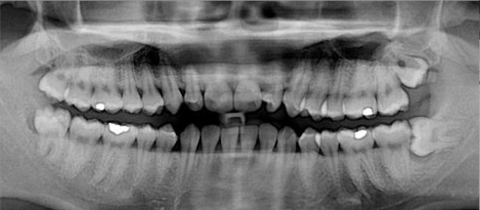What is the most common disease in the world? Infections probably come to mind. Or heart disease, or cancer, or perhaps even AIDS. Actually, it is the common cold! And what comes in second? Tooth decay! Clearly, cavities are unsightly and can cause pain. But poor oral health can also allow bacteria to enter the bloodstream and precipitate respiratory or heart problems. Luckily, though, tooth decay is preventable. Proper oral hygiene and reducing sweets in the diet are of essence, but it is also possible to make teeth more resistant to decay by chemical intervention. We are of course talking about using fluoride.
Tooth enamel is mostly composed of hydroxyapatite, a substance readily damaged by acids. Naturally occurring bacteria in the mouth, streptococcus mutans in particular, feed on sugars, metabolize these to acids, and presto, cavities appear. However, if fluoride is supplied in the diet, or applied to teeth topically, it gets incorporated into the structure of the tooth, forming a more acid-stable substance called fluoroapatite. Studies show that contrary to previously held beliefs, most of the effect of fluoride is topical and occurs after teeth have erupted into the mouth. Fluoride has a secondary effect as well. It can interfere with the activity of enzymes, such as the ones bacteria use to convert sugars into acids. Since tooth decay is a universal problem, it would seem that a simple method of prevention, namely the addition of tiny amounts of fluoride to drinking water, would be a welcome solution.
Indeed many health authorities claim that water fluoridation has been one of the most effective and safest public health interventions ever introduced. But not everyone shares this view. There are those who claim that fluoridation is basically misguided, ineffective and risky. It’s only done, they say, because governments, industry and the U.S. military have conspired with public health authorities to change the image of a toxic byproduct of the fertilizer industry to a safe tooth decay preventor. Why? So that it can be disposed of in our drinking water! These culprits, the anti-fluoridationists claim, have also colluded to keep data about the risks of fluoride from the public and have attempted to undermine the careers of scientists who present opposing views. Controversy of course is no stranger to science, but it is rare to see an issue that generates as much verbal venom, and as much misrepresentation of the scientific literature as the flouridation of public water supplies. And that goes for both sides of the ledger!
First a little history. In 1901, Frederick McKay opened a dental practice in Colorado Springs, Colorado, and immediately noted that many of his patients had stained or mottled teeth, a condition now known as fluorosis. But he was surprised to find that people who had these unsightly teeth also had very few cavities. The link turned out to be a very high level of fluoride in the Colorado Springs drinking water. McKay’s observation then spurred comparisons of the dental health of communities with different amounts of fluoride in the water. When the natural fluoride concentration was greater than 1 part per million, the incidence of cavities was seen to be reduced by some 50-65%. At this level, only about 10% of children showed the faintest signs of fluorosis, and consequently the World Health Organization began to recommend supplemental fluoride where levels were low.
In 1945 Grand Rapids, Michigan became the first city in the world to adjust its drinking water to a fluoride concentration of 1 ppm. Brantford, Ontario followed the same year. In fact, Brantford took part in the first epidemiological survey of fluoride. In 1948 and 1959, the incidence of cavities was compared with Sarnia, which had a very low level of fluoride in the water, and with Stratford, which had a concentration of 1.6 ppm. Sarnia had a high incidence of cavities both in 1948 and 1959, with 90 % of children in the 9-11 age group having cavities, whereas Stratford had a low incidence with only 50% of the children affected. In Brantford from 1948 to 1959, the incidence of cavities dropped from 90% to 50%. As a result, Sarnia introduced water fluoridation. Today, at least in North America, fluoridation is widespread. The American Dental Association is a strong advocate of adding fluoride to water and estimates that every dollar spent on fluoridation saves about fifty dollars in future dental expenses.
From the beginning, fluoridation pushed buttons. Opponents objected to “rat poison” being added to their water supply and claimed that the government had no right to determine the type of water people should drink. Emotions ran high, mistrust flourished. In March 1944, authorities in the Newburgh area of New York announced that the town’s water would be fluoridated. On the day that fluoridation had been scheduled to begin, local health officials were startled to receive complaints about discolored saucepans, digestive troubles and cracked dentures. In fact, the fluoridation equipment had not been ready on time and no changes had been made to the water! But the public’s imagination had already been primed. It seems that if you expect symptoms, you just may get them.
Water fluoridation does reduce the incidence of cavities. The extent to which this happens, though, is debatable. In recent years the ready availability of fluoride toothpastes, mouthwashes and dietary supplements has reduced the effects attributable to fluoridated water in more affluent areas. Underprivileged communities are the ones that are the most likely to see the benefits of a fluoridated water supply. But at what risk? After all, the critics are correct when they refer to fluoride as “rat poison.” So, should we worry? Are humans just giant rats? With some exceptions, no. Still, the issue of the safety of fluoride merits discussion.
Fluoride can be toxic, there is no doubt about it. As the opponents of water fluoridation constantly remind us, it has indeed been used to poison rats. This, however, has no bearing on whether or not we should add fluoride to drinking water to improve dental health. Toxicity is always a question of dose! A mouthful of pure sodium fluoride will kill a rat, but the rodent would have to drink roughly a hundred liters of fluoridated tap water before suffering the same fate if the water had the usual fluoride concentration of 1 part per million. And it would have to do this without urinating! Labeling a substance as a “poison” without putting it into the proper context is meaningless and irresponsible. After all, we use “poisons” all the time. The chlorine we use to purify our water can also be used as a chemical weapon. Morphine is an excellent pain killer, but at doses just slightly higher than that needed to alleviate pain, it can put you to sleep. And it doesn’t take much more to put you to sleep permanently. Aspirin at a high dose can kill, as can table salt or iron supplements, or fluoridated toothpaste. It might be a challenge to do so without vomiting, but in theory one could down a lethal dose of fluoridated toothpaste. Still, this has nothing to do with adding fluoride to water, or indeed, to toothpaste.
Neither has the fact that fluoride is used to enrich uranium for nuclear weapons, or to prepare Sarin nerve gas, or to isolate aluminum from its ore have anything to do with water fluoridation. And arguing against fluoridation by bringing up the CIA’s supposed attempt to study a dinitrofluoride derivative of acetic acid as a potential mind-controlling substance is just absurd. Anti-fluoridationists also relish in pointing out that hydrofluorosilic acid, the chemical commonly used to fluoridate water supplies, is a waste byproduct of the fertilizer industry. This is true enough, but so what? If anything, converting an industrial waste to a useful substance instead of discarding it, is highly desirable. These anti-fluoride arguments are as inane as Senator Joe McCarthy’s charge in the 1950s that fluoridation was a communist plot to poison America, or as others alleged, that it was a masterful stroke by the sugar industry to increase sales of sweets without affecting children’s’ teeth. Anti-fluoridationists, I think, actually harm their cause by using such irrelevant arguments as well as with their excessive fear-mongering. The truth is that there may be legitimate reasons to take a more careful look at the issue.
The major allegations that have been aimed at water fluoridation are as follows: it increases the risk of bone fracture and bone cancer, it may interfere with thyroid function as well as with other biological systems, it may expose the public to contaminants inherent to hydrofluorosilicic acid production and it may cause fluorosis of the teeth. Only the last of these is a clear concern. Dentists do report seeing more teeth with the hallmark white stains of fluorosis in areas where fluoride is added to water. While this is only a cosmetic problem, nevertheless, it is a problem. Why is it happening? Because due to the widespread use of fluoridated toothpaste, fluoride mouth rinses and processed foods and beverages made with fluoridated water, some segments of the population may be exposed to more than the optimal amount of fluoride. It is also quite clear that due to these sources of fluoride, as well as to earlier and better dental care, the gap in incidence of cavities between fluoridated and non-fluoridated areas has narrowed considerably. Although such statistics are hard to confirm, the current incidence of cavities in Vancouver, which has never fluoridated its water, seems about the same as in Toronto, which has added fluoride for more than thirty years.
The other claims against fluoridation are much more nebulous. While laboratory studies and some animal experiments suggest that fluoride can trigger cancer, extensive epidemiological investigations in fluoridated and non-fluoridated communities have shown no difference in cancer rates except for the possibility of a rare type of bone cancer in boys. Fluoride, as can be expected, incorporates into bones as well as into teeth, but some research indicates, surprisingly, that in this case it may lead to a weakening of bones. Again, epidemiological studies have shown that if there is a risk of increased fractures, it is a very small one. Fluoride does interfere with enzyme systems; after all that is the way it controls bacteria in the mouth. In theory then, it can have a negative effect on various body functions. But theory is not the same as evidence. Hydrofluorosilicic acid, as fluoridation opponents point out, can indeed be contaminated with trace amounts of lead, arsenic and radium, all of which are undesirable. But the amounts that end up in drinking water from this source are less than what is naturally present in many water systems. It is also interesting to note that tea is a much higher source of fluoride than fluoridated water, but no adverse effects have been linked to its consumption.
The fluoride issue heated up in March of 2006 when the National Research Council in the U.S. released its report entitled “Fluoride in Drinking Water: A Scientific Review of the Environmental Protection Agency’s Standards.” Press coverage was extensive, with most articles accurately reporting the overall recommendation that the maximum allowed level of fluoride in drinking water should be reduced from the current level of 4 parts per million. But then reporters went on to interpret this as a call to action about the safety of water fluoridation. This was quite a leap! Let’s take a moment to analyze what this report really stated and what conclusions can be drawn.
Back in 1986, the Environmental Protection Agency, based on the then available evidence, established 4 ppm as the maximum contaminant level goal for fluoride in water. This was based on the fact that concentrations above this actually caused weakening of tooth enamel. There was no suggestion that 4 ppm was associated with any other hazard. At least not from the EPA. Anti-fluoridation groups had other views. They claimed that fluoride in water presented a risk for musculoskeletal, neurobehavioural and endocrine problems and even suggested that it could cause cancer. Numerous studies on all aspects of fluride in water have appeared since the 4 ppm maximum was set in 1986 and EPA decided it was time to review the evidence to determine if that maximum was still appropriate.
After examining the most recent toxicological, epidemiological and clinical studies, the expert panel concluded that severe enamel fluorosis can occur in children even at 4 ppm fluoride in water, and that consuming water at this level continuously can lead to weakened bones and increased risk for fractures. Based on this evidence the panel recommended that the 4 ppm maximum be reduced. Now for the important point. When fluoride is added to drinking water to prevent cavities, it is added to bring the final concentration to between 0.7 and 1.2 ppm. Not anywhere near 4 ppm! Who then is at risk from drinking water with a 4 ppm fluoride content? About one half of one percent of North Americans who drink water that has a natural fluoride content of 4 ppm or more. So this amount of natural fluoride in water is a potential problem, but the NRC report said absolutely noting about any risk from the 1 ppm fluoride added to community water supplies. And the NRC scientists looked at all the evidence, including such things as hormonal issues and cancer. They found no adverse health effects, other than weakened enamel and slight weakening of bones, even at 4 ppm! And there was certainly no recommendation to reduce fluoridation below the usual 1 ppm. Of course we can’t conclude that some future study may not raise some other fluoridation issue, but interpreting this NRC report to mean that adding fluoride to water at a level of 1 ppm presents a risk is plainly wrong.
Where does this leave us? Water fluoridation is not a likely cause of significant health problems, but in the face of recent research showing that the benefits of fluoride are mostly topical, the amount added to drinking water can be legitimately questioned. Fluoride toothpastes, fluoride treatments by dentists, and fluoride present in food and drinks may get most of the job done so that less than 1 ppm in water may be sufficient. Of course, this scenario may not hold for poorer communities. Overall the benefits of fluoride outweigh the risks. In any case, the decision of whether to fluoridate or not has to be based on evolving science, and not on fluoride’s ability to act as a “rat poison.” After all, Coumadin, a “blood thinner” that saves thousands of lives a year, was originally used to kill rats! But of course only the dose makes the poison.







